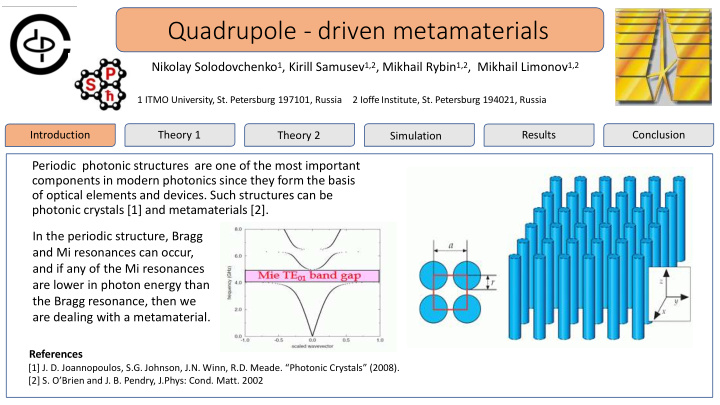



Quadrupole - driven metamaterials Nikolay Solodovchenko 1 , Kirill Samusev 1,2 , Mikhail Rybin 1,2 , Mikhail Limonov 1,2 1 ITMO University, St. Petersburg 197101, Russia 2 Ioffe Institute, St. Petersburg 194021, Russia Introduction Theory 1 Results Conclusion Theory 2 Simulation Periodic photonic structures are one of the most important components in modern photonics since they form the basis of optical elements and devices. Such structures can be photonic crystals [1] and metamaterials [2]. In the periodic structure, Bragg and Mi resonances can occur, and if any of the Mi resonances are lower in photon energy than the Bragg resonance, then we are dealing with a metamaterial. References [1] J. D. Joannopoulos , S.G. Johnson, J.N. Winn, R.D. Meade. “Photonic Crystals” (2008). [2] S. O’Brien and J. B. Pendry, J.Phys: Cond. Matt. 2002
Quadrupole - driven metamaterials Nikolay Solodovchenko, Kirill Samusev, Mikhail Rybin, Mikhail Limonov Theory 1 Theory 2 Simulation Results Conclusion Introduction Increase of dielectric constant Goal of theoretical work As the dielectric constant increases, the frequency At a large dielectric constant, the TE 11 resonance is observed of the Mie resonance decreases, thus, the Mie lower in photon energy than the Bragg resonance, which means resonance will be lower in energy than the Bragg that there is a quadrupole-driven metamaterial in a certain resonance. Then, at large values of the dielectric frequency range. Thus, the aim of this work is to describe the constant, we will observe the Mie quadrupole quadrupole-driven metamaterial resonance with a lower energy than the Bragg resonance References [3] M. V. Rybin, D. S. Filonov, K. B. Samusev, P. A. Belov, Y. S. Kivshar & M. F. Limonov, Nat. Com., 6 ,10102 (2015)
Title of Your Paper Quadrupole - driven metamaterials Nikolay Solodovchenko, Kirill Samusev, Mikhail Rybin, Mikhail Limonov Theory 1 Theory 2 Simulation Results Conclusion Introduction TE 11 materials TE 01 materials Let's choose a frequency range where quadrupoles will make Dipole metamaterials have been studied for a the greatest contribution to the scattered field. The field long time, and works have been written that created by the quadrupole can be calculated as: describe these materials in various ways: Rigorous coupled-wave analysis (RCWA) + discrete dipole approximation (DDA) [4] (“coins”) or, for example, metamaterials where is the quadrupole Green's function, the tensor of composed of sparse high-index dielectric rods the third rank, and is the quadrupole tensor, which is allow a homogenization procedure by using the defined as: approach proposed in work [5] References [4] I. M. Fradkin, S. A. Dyakov & N. A. Gippius, where is the quadrupole polarizability of a single arXiv:1812.11359v3, (2019) [5] O’Brien, S., Pendry, J. B., J. Phys. Condens. Matter 14, 4035 cylinder (2002)
Quadrupole - driven metamaterials Nikolay Solodovchenko, Kirill Samusev, Mikhail Rybin, Mikhail Limonov Theory 1 Theory 2 Simulation Results Conclusion Introduction Effective polarizability Polarizability calculation Quadrupole polarizability on a single particle is since all quadrupoles create a field that acts on others proposed to be calculated using the software package COMSOL Multiphysics. using the Bloch theorem and introducing the notation introducing the effective polarizability in the form we can finally express it
Quadrupole - driven metamaterials Nikolay Solodovchenko, Kirill Samusev, Mikhail Rybin, Mikhail Limonov Theory 1 Theory 2 Simulation Results Conclusion Introduction Results Calculations ε = 80 Experiment Work in progress
Quadrupole - driven metamaterials Nikolay Solodovechenko 1 , Kirill Samusev 1,2 , Mikhail Rybin 1,2 , Mikhail Limonov 1,2 1 ITMO University, St. Petersburg 197101, Russia 2 Ioffe Institute, St. Petersburg 194021, Russia Introduction Theory 1 Simulation Simulation Results Conclusion 1. The basis for the construction of the theory of quadrupole- driven metamaterials has been prepared; 2. It is necessary to numerically find the value of the polarizability of a single cylinder, find the effective polarizability; 3. And finally, compare the results that we will get in the future with the experiment. n.solodovechenko@metalab.ifmo.ru
Recommend
More recommend